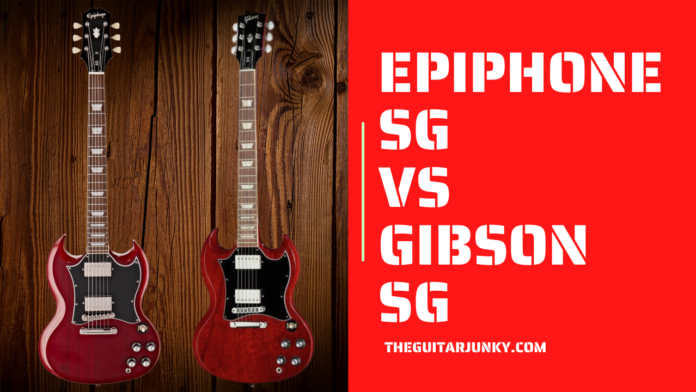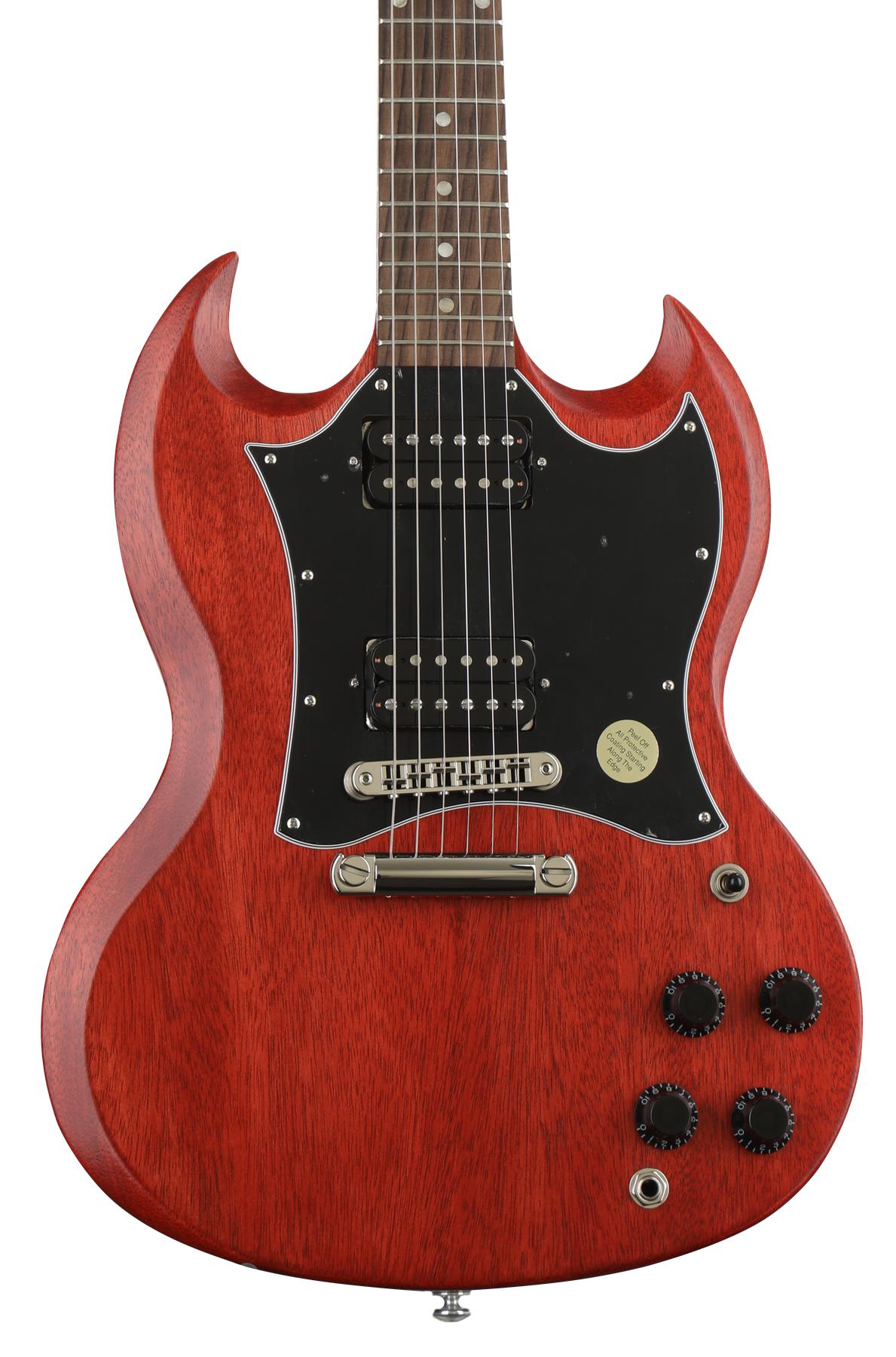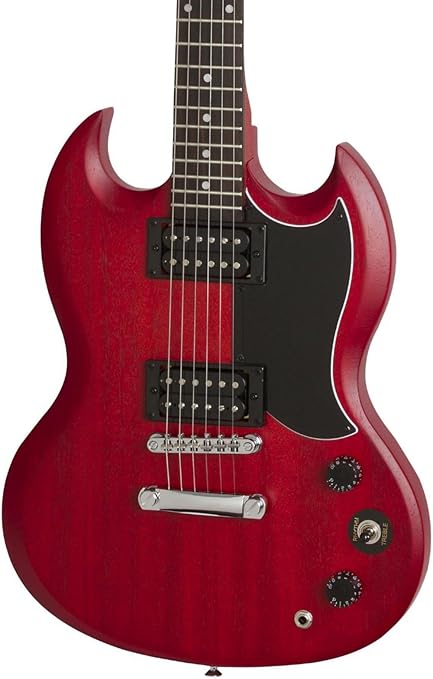AC/DC’s Angus Young and Black Sabbath’s Tony Iommi are hardcore fans of the Gibson SG.
While these guitars are famous in rock n’ roll and heavy metal circles, they are also perfect for country, blues, and jazz. The SG’s sound, vibe, and looks are enough to make it one of the world’s most iconic electric guitars. There is one problem, though. The Gibson SG is mighty expensive.
Enter the Epiphone SG. While it is safe to assume that the Epiphone SG is nowhere near the performance of a Gibson SG, most beginner and intermediate guitarists will never know the difference.
Editor's Choice | Runner Up |
Pickups: 490R Humbucker + 490T Humbucker | Pickups: 650R Ceramic-8 Humbucker + 700T Ceramic-8 Humbucker |
Body Type: Solidbody Mahogany | Body Type: Solidbody Poplar |
Controls: 2 x volume, 2 x tone, 3-way toggle pickup selector | Controls:1 x master volume, 1 x master tone, 3-way toggle pickup switch |
Contents
Gibson SG
One of the world’s most iconic electric guitars, the Gibson SG continues on the legendary following of the Gibson Les Paul. This guitar features revolutionary 490R/T humbuckers to its mahogany-rosewood construction and premium-quality electronics, making it more than ready to take center stage.
Also Read: Gibson SG Special vs Standard – Differences, and Which is Better?
Epiphone SG
The Epiphone SG is a novice and intermediate guitarist’s best instrument for playing hardcore rock n’ roll and heavy metal pieces without breaking the bank. It has a great-sounding Alnico Classic PRO humbuckers and a form factor that resembles the legendary Les Paul, enough to wow the crowd.
Construction
Each guitar comes in different versions. However, they all share the same characteristics under each SG category.
In general, the Gibson SG features more premium-quality materials for its construction, complete with finer details and exquisite cosmetic additions. Both guitars come with mahogany necks and bodies. However, they have different wood specs for the fingerboard, with Gibson opting for premium rosewood and Epiphone going the budget route with pau ferro.
It is worth pointing out that they do not look very different when viewed at a distance. Only the keen eye of a master craftsman can distinguish the rosewood from the pau ferro. One should understand that pau ferro has the same sonic and textural characteristics as rosewood, making it a more economical alternative.
The guitars also have subtle differences in the shape of their headstock and pickguard. Again, novice guitarists will never spot the variance.
Hardware
While the Epiphone SG may not look different from the Gibson SG, one must listen to its sound quality. Since both guitars feature a mahogany structure, their sound performance boils down to the pickups they integrate into their design.
Gibson uses the tried and tested 490R and 490T humbuckers for its bridge and neck pickups, respectively. These humbuckers give the Gibson SG phenomenal tonal characteristics, slaying hard rock and heavy metal with ease while allowing for versatility in playing the blues and jazz.
The 490R/T set complements the warm nature of mahogany tonewood, eliminating the boomy and muddy sounds present in the wrong tonewood-pickup combination.
On the other hand, Epiphone uses a pair of Alnico Classic PRO humbuckers. These pickups provide good quality sound, considering the Epiphone SG’s price.
Interestingly, the company did not use its ProBucker series of humbuckers, which are famous for producing sound quality almost similar to the Gibson SG’s 490R/T series.
The three-way selector switch, tone control, and volume controls are standard on both guitars. However, one can expect the Gibson SG’s electronics and hardware to be high quality. The good news is that Epiphone has been making substantial improvements through the years to close the gap.
Playability
The Epiphone SG is lighter than its Gibson counterpart, making it a joy to play among newbies and young guitarists. However, some folks may find its 1960s-era slim taper-D neck profile less comfortable than the Gibson SG’s rounded design.
Price
A Gibson SG Standard can cost between $1,000 and $2,000, depending on finish options and other additions. A more affordable version of the Gibson SG Standard, the SG Special, can net anywhere between $1,200 and $1,500.
On the other hand, the Epiphone SG can set potential owners back by about $179 to $200, depending on the retailer.
Also Read: Gibson SG vs Les Paul
Conclusion
The Gibson SG is a masterpiece in the world of rock n’ roll and heavy metal music. There are many reasons why the music kingdom’s greatest artists prefer this electric guitar over others, including the elegant look of a classic piece and the concert-ready performance of a virtuoso instrument.
However, its price remains the Gibson SG’s Achilles heel. That is why the Epiphone SG entered the scene to offer novice and intermediate guitarists a Les Paul-like guitar experience without the hefty price tag.




